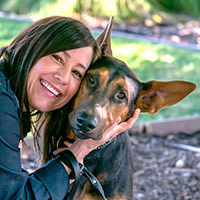Blood Donor Dogs: The Importance of Canine Blood Transfusion
Can your dog give the gift of life?

share article

Your pet wants you to read our newsletter. (Then give them a treat.)
Eight-year-old Yorkie mix, Kimiko, was saved by an unlikely hero when she was on the brink of death. Kimiko was in dire straits, as she was severely anemic, emaciated, unresponsive and hypothermic when she was brought to the Arizona Humane Societyopens in a new tab by an Emergency Animal Medical Technician. Her situation was so grave that veterinarians weren’t sure she was going to make it but wanted to give her every chance at survival possible. That’s when they turned to an innovative medical procedure uncommon in animal shelters: dog blood donation. Here’s everything you need to know about dog blood transfusions and blood donations.
What is a dog blood transfusion?
A dog blood transfusion is a medical procedure in which a donor dog’s blood is intravenously incorporated into the dog patient’s blood supply, increasing blood levels after trauma, disease, or anemia. The need for dog blood transfusionsopens in a new tab is frequent in many veterinary hospitals and can be crucial in many situations, including trauma, immune disorders, and blood loss during surgery.
Typically, the cost of a blood transfusion ranges from $100-$300 per unit of blood, but the total cost depends on what caused the blood loss and the procedure that required the transfusion.
Finding a dog blood transfusion donor.
To save Kimiko’s life, vets knew she needed a blood transfusion urgently. When a lifesaving blood transfusion is recommended, the natural question by worried pet parents is, “Where do dog blood donors come from?” You might be surprised to find that there are canine blood banks just like those for people.
Veterinary blood banks are a relatively new concept developed during the past few decades. There are two kinds of blood banks: collection centers using volunteer dogs and centers that house and care for their own group of donor dogs living on the blood bank grounds.
Volunteer Blood Donor Programs
Community-based canine donor programs rely on volunteers to bring in their pets for blood donation. There are several veterinary schools that participate in this kind of program, including the University of California, Davis, School of Veterinary Medicine (see more programs below). There are incentives for volunteers, including free annual health exams and blood work, heartworm prevention and free dog food. Some programs even offer a return gift of blood at no cost if the donor ever needs it during their lifetime.
Animal Blood Banks
Animal Blood Resources is an example of the second type of blood bank. It obtains donors through partnerships with rescue groups, providing a working solution for unwanted adult dogs and cats. These donors are given a temporary home where volunteers care for them. After one year of providing their lifesaving service, every animal is adopted into a permanent home.
In Kimiko’s case, veterinarians couldn’t reach out to dog blood banks because there was no time. As luck would have it, another patient receiving medical care was able to help donate blood with a lifesaving procedure. Jasmine, a one-year-old Labrador Retriever mix being treated for a broken leg, was the perfect pup for the procedure because they had matching blood types.
Do dogs have blood types?
Dogs have six major (but up to 13 different) blood types. Blood types are determined by various proteins and sugars in the red blood cells. But what makes blood typing more complex is that each blood type can be inherited independently, meaning multiple combinations exist. Dogs also have universal blood donors similar to type-O universal human donors. These super dogs have a blood group called Dog Erythrocyte Antigen (DEA) 1.1 negative.
After receiving the blood transfusion, Kimiko’s vitals immediately started trending upward. Originally unable to stand or eat due to being so weak, she’s now wagging her tail and will even roll over for belly rubs — a telltale sign that she’s feeling much better. Maybe some of Jasmine’s sweet Lab personality came with the transfusion.
How does a dog become a blood donor?
Pretty much any dog can be a blood donor, but here are the most common blood donor dog requirements:
Dogs must be between one- to six-years-old
Weigh at least 55 pounds
Be free of any medications
Prior to becoming a donor, all dogs are screened for infectious diseases and are given a full veterinary exam to ensure that only healthy dogs enter a donation program. Then, their blood type is determined.
Donor dogs can “roll up their fur sleeves” every two to three months, but this varies by the blood bank. Sedation is not needed — just plenty of head rubs and treats. The blood draw takes about 10 minutes. A single donation can be used to save up to four lives because the blood can be separated into two components, red blood cells and plasma. Interestingly, cats and dogs have different blood types, so they cannot donate blood to each other. But in a few rareopens in a new tab emergency circumstances, donor dog blood has been used in cats when an immediate source of cat donor blood was not available.
Interested in having your dog become a donor or adopting a retired donor? See our resource list below, or ask your veterinarian and local shelter.
Dog Blood Banks
University of California - Davis: Blood Bank & Transfusion Centeropens in a new tab
Colorado State University: VTH Blood Bankopens in a new tab
University of Florida: UF Canine Blood Bankopens in a new tab
Iowa State University: Veterinary Medical Center Animal Blood Bankopens in a new tab
Kansas State University: K-State Animal Blood Bankopens in a new tab
North Carolina University: NC State Veterinary Hospitalopens in a new tab
Ohio State University: OSU Animal Blood Bankopens in a new tab
University of Pennsylvania: Penn Animal Blood Bankopens in a new tab
Michigan State University: MSU Blood Donor Programopens in a new tab
The University of Minnesota: Companion Animal Blood Bankopens in a new tab
University of Wisconsin: School of Veterinary Medicine Blood Bankopens in a new tab
DoveLewis Emergency Hospital: Animal Blood Bankopens in a new tab

Dr. Shea Cox, DVM, CVPP, CHPV
Dr. Shea Cox is the founder of BluePearl Pet Hospice and is a global leader in animal hospice and palliative care. With a focus on technology, innovation and education, her efforts are changing the end-of-life landscape in veterinary medicine.
Related articles
![A dog sitting comfortably on a women's lap.]() opens in a new tab
opens in a new tab1 in 10 Dogs Will Get Kidney Disease. Here’s What to Do
It can’t be cured, but it can be managed. Partnering with your vet will be the key.
![Man hugs his dog to his face]() opens in a new tab
opens in a new tabHow Will I Know When It’s Time?
End-of-life veterinary specialist Dr. Shea Cox on how to make the most difficult decision in your pet parenting journey.
![]() opens in a new tab
opens in a new tabScared Stiff: How to Spot Tetanus in Dogs
Yes, dogs can get tetanus too — and not just from rusty nails.
![A dog outside with his mouth open coughing]() opens in a new tab
opens in a new tabLaryngitis in Dogs: Causes and Treatment
Vet advice on when you should be worried.




